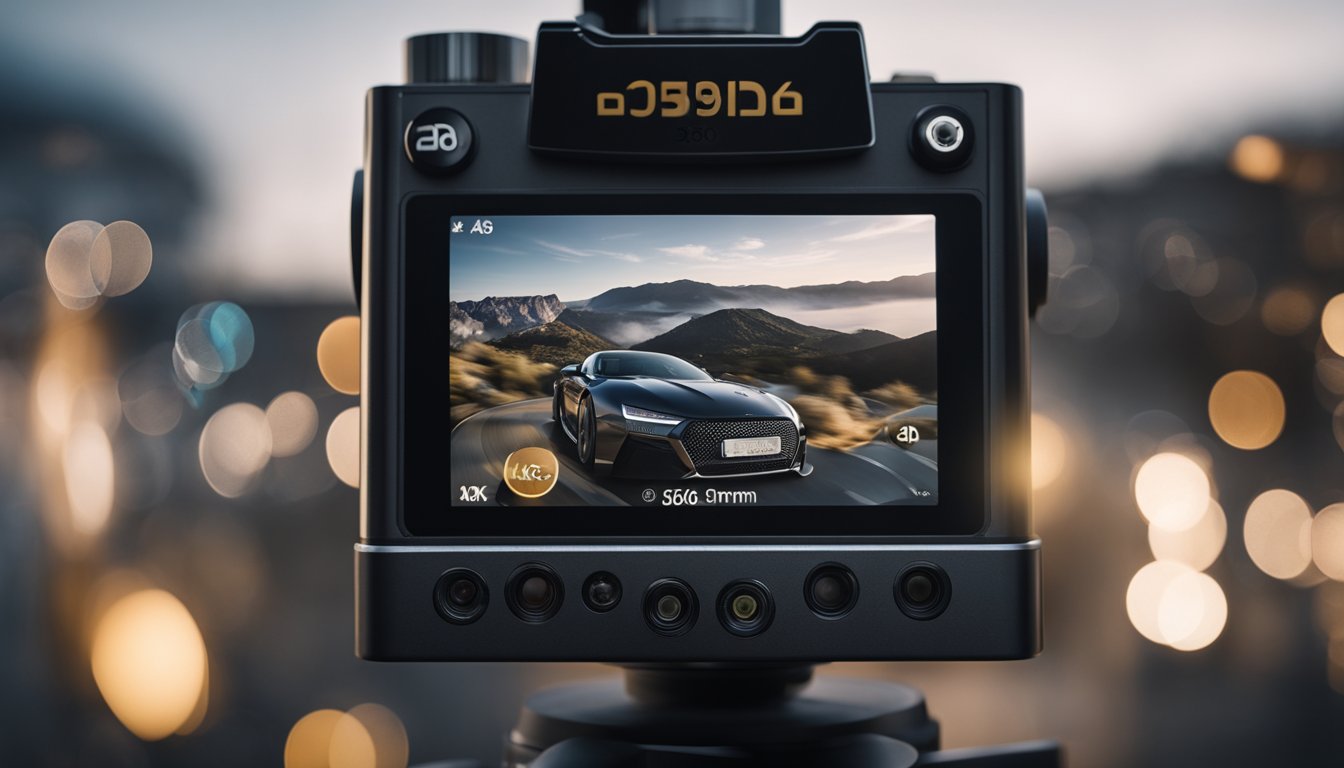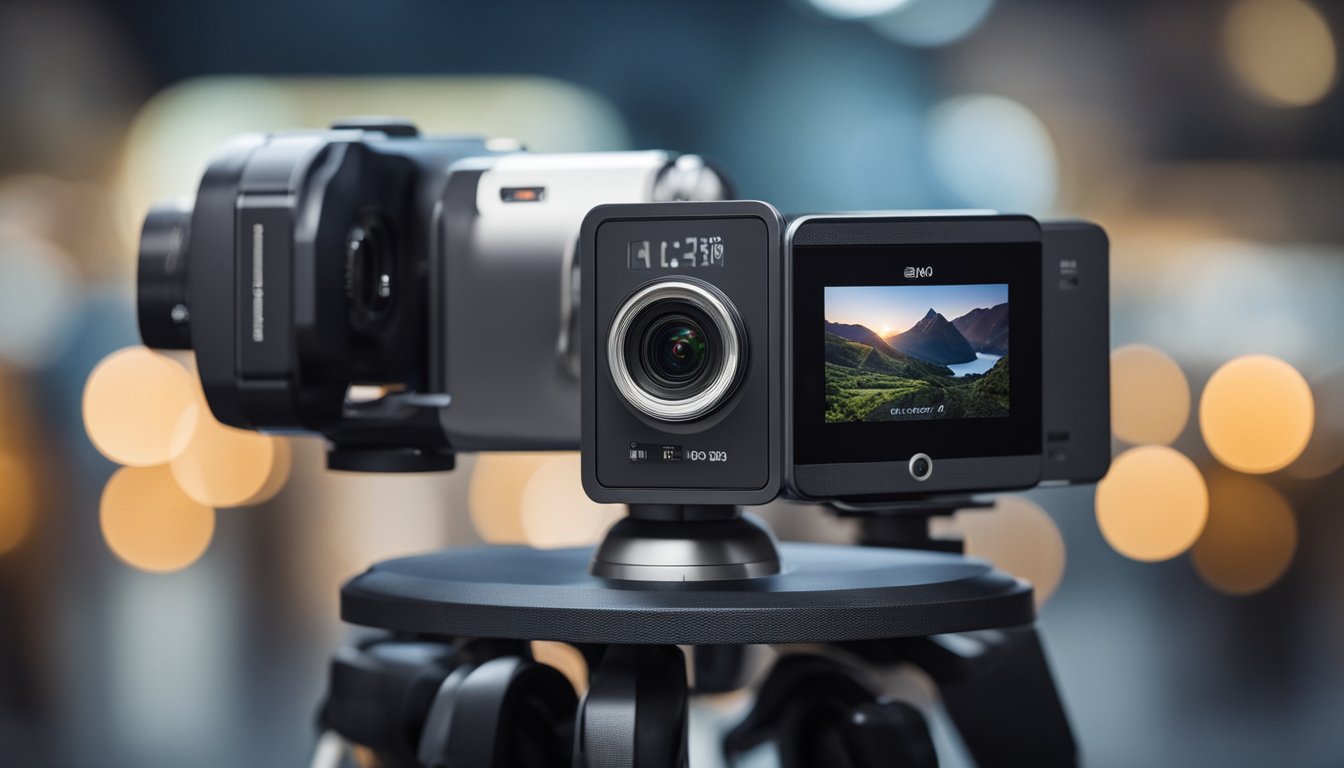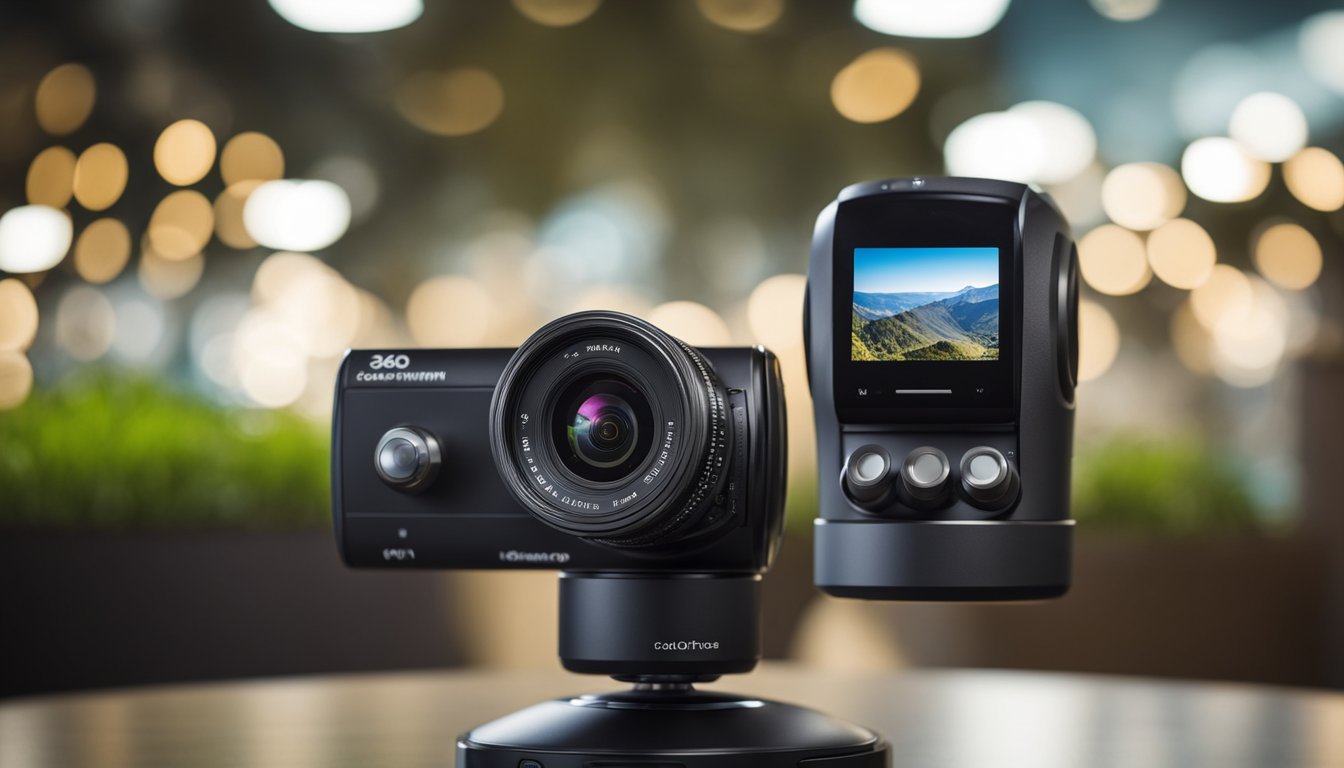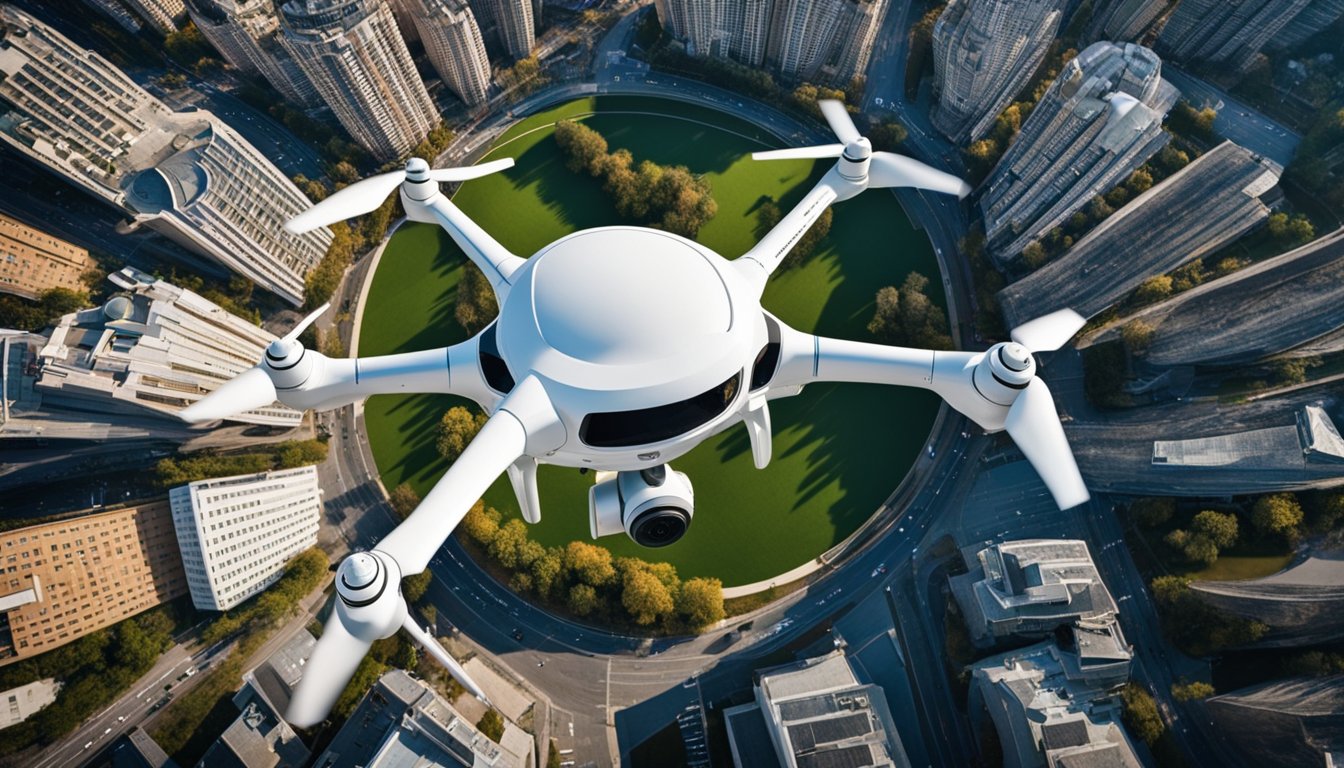If you’re considering purchasing a 360-degree camera, you’re likely wondering about the cost. The price of 360-degree cameras can vary widely depending on the brand, model, and features. It’s important to understand what factors contribute to the cost and what you should consider when making a purchase.
In addition to the initial cost of the camera, you should also factor in additional expenses such as accessories, software, and storage solutions. Understanding the full scope of expenses will help you make an informed decision when investing in a 360-degree camera.
Key Takeaways
- The cost of 360-degree cameras can vary based on brand, model, and features.
- Consider additional expenses such as accessories, software, and storage solutions when budgeting for a 360-degree camera.
- Understanding the full scope of expenses will help you make an informed decision when investing in a 360-degree camera.
What Is a 360 Degree Camera?
If you’re looking to create immersive video content, then a 360-degree camera is a great option. A 360 camera is a device that captures everything around itself at once using two or more lenses. This allows you to create spherical video content that can be viewed in virtual reality (VR) or on a computer or mobile device.
Understanding 360 Video and VR Content
360-degree video is a type of video that allows the viewer to look in any direction. This is achieved by using a 360 camera to capture video from all angles, which is then stitched together into a single video file. When viewed on a device that supports it, the viewer can look around the scene as if they were there in person.
VR content takes this a step further by allowing the viewer to interact with the environment. This is achieved by using a VR headset, which tracks the viewer’s head movements and adjusts the video accordingly. This creates a more immersive experience, as the viewer can move around and explore the scene in a more natural way.

When it comes to pricing, 360-degree cameras can range from a few hundred dollars to several thousand dollars. The price will depend on the camera’s features, such as video resolution, frame rate, and image stabilization. Some popular brands of 360-degree cameras include GoPro, Insta360, and Ricoh.
In summary, a 360-degree camera is a device that captures video from all angles, allowing you to create immersive content that can be viewed in VR or on a computer or mobile device. Prices for 360-degree cameras vary depending on the camera’s features, but there are plenty of options available for those looking to get started with this exciting technology.
Key Features of 360 Cameras
If you’re in the market for a 360 camera, there are several key features that you should consider before making a purchase. Here are some of the most important features to keep in mind:
Resolution and Image Quality
One of the most important features of a 360 camera is its resolution and image quality. The higher the resolution, the better the image quality will be. Many 360 cameras on the market today offer 4K, 5.7K, and even 8K resolution. Keep in mind that higher resolution cameras will generally be more expensive.
Stabilization Technology
« Do 360 Cameras Have Sound? Exploring Audio Features in 360 Cameras
How Much Does a 360 Degree Camera Cost? A Guide to Affordable Options »
Another important feature to consider is stabilization technology. Some 360 cameras come with built-in stabilization technology that helps to reduce shakiness and improve the overall quality of your footage. For example, the Insta360 ONE X2 features FlowState stabilization, which helps to keep your footage smooth and steady even when you’re on the move.
Waterproof Capabilities
If you plan on using your 360 camera in wet or rainy conditions, it’s important to choose a camera with waterproof capabilities. Many 360 cameras are water-resistant or waterproof up to a certain depth, so be sure to check the specifications before making a purchase.
Battery Life and Performance
Finally, battery life and performance are important factors to consider when choosing a 360 camera. Some cameras offer longer battery life than others, and some cameras may perform better in low-light conditions or other challenging environments. Be sure to read reviews and check the specifications to find a camera that meets your needs.
Overall, when choosing a 360 camera, it’s important to consider your specific needs and use cases. By keeping these key features in mind, you can find a camera that will help you capture stunning 360-degree footage with ease.
Popular 360 Camera Models in 2023
https://www.youtube.com/watch?v=EqzqBFLTrFE&embed=true
If you are looking for a 360 camera to capture stunning panoramic images and videos, you have plenty of options to choose from in 2023. Here are some of the most popular 360 camera models available today.
Insta360 Series
Insta360 is one of the leading brands in the 360 camera market, offering a wide range of models to suit different needs and budgets. The Insta360 X3 is a popular choice for those who want a high-quality 360 camera that can shoot 5.7K video and capture photos with impressive detail. It comes with a range of features, such as Active HDR, FlowState stabilization, and InstaPano mode, which makes it easy to create stunning panoramic images.
Another popular Insta360 camera is the Insta360 ONE R, which is a modular camera that can be customized to suit your needs. It has a 1-inch sensor that can capture 5.3K video and 19MP photos, as well as a range of accessories that make it easy to mount the camera in different situations.
GoPro 360 Cameras
GoPro is another well-known brand in the action camera market, and it has also entered the 360 camera market with its GoPro Max model. The GoPro Max is a versatile camera that can shoot 5.6K video and capture 360-degree photos. It comes with a range of features, such as HyperSmooth stabilization, TimeWarp, and Max SuperView, which makes it easy to create stunning content.
Ricoh Theta Lineup
Ricoh is a Japanese company that has been producing 360 cameras for many years, and its Theta lineup is one of the most popular in the market. The Ricoh Theta SC2 is a compact camera that can shoot 4K video and capture 14MP photos. It comes with a range of features, such as face detection, night mode, and interval shooting, which makes it easy to create stunning content in different situations.
Another popular Ricoh Theta camera is the Ricoh Theta Z1, which is a high-end model that can capture 23MP photos and shoot 4K video at 30fps. It comes with a range of features, such as RAW support, 360-degree spatial audio, and a large OLED display, which makes it a great choice for professional photographers and videographers.
Overall, these are some of the most popular 360 camera models available in 2023. Whether you are a professional photographer or videographer, or just someone who wants to capture stunning panoramic images and videos, there is a 360 camera out there that can meet your needs and budget.
Choosing the Right 360 Camera
https://www.youtube.com/watch?v=5MvtlBYOFHg&embed=true
When it comes to choosing the right 360 camera, there are a few things you should consider before making a purchase. Here are some things to keep in mind:
For Action and Sports
If you’re looking for a 360 camera to capture your adventures, you’ll want to look for an action cam that can withstand the elements. Look for a camera that is waterproof, shockproof, and dustproof. A camera with built-in stabilization will also help smooth out any bumps in your footage. The Insta360 ONE R is a great option for action and sports enthusiasts, with its rugged design and waterproof casing.
For Professional Photography
If you’re a professional photographer looking to add 360 photography to your portfolio, you’ll want to look for a camera with high resolution and advanced features. Look for a camera with a large sensor, high megapixel count, and RAW support. The GoPro MAX is a great option for professional photographers, with its 16.6-megapixel sensor and 360-degree video stitching.
For Virtual Tours and Real Estate
If you’re a real estate agent or virtual tour creator, you’ll want a camera that can capture high-quality images and video for your clients. Look for a camera with high resolution, good low-light performance, and easy-to-use software for stitching together your footage. The Ricoh Theta Z1 is a great option for virtual tours and real estate, with its 23-megapixel sensor and easy-to-use software.
No matter what your needs are, there is a 360 camera out there that can meet them. Take the time to research your options and find the camera that is right for you.
Understanding Camera Specifications
https://www.youtube.com/watch?v=07x9yyui6UY&embed=true
When it comes to buying a 360-degree camera, understanding camera specifications is crucial. This section will break down some of the most important specifications to consider when purchasing a 360-degree camera.
Sensor Size and Dynamic Range
The sensor size is an important factor to consider when buying a 360-degree camera. A larger sensor size means better image quality, especially in low light conditions. Dynamic range is also important as it determines the range of light that the camera can capture. A higher dynamic range means that the camera can capture more detail in both bright and dark areas.
Lens Types and Aperture
There are two types of lenses used in 360-degree cameras: fisheye and dual-lens. Fisheye lenses provide a wider field of view but can result in distortion around the edges of the image. Dual-lens cameras use two lenses to capture a 360-degree image, resulting in a more accurate representation of the scene.
Aperture is another important specification to consider when buying a 360-degree camera. A wider aperture (lower f-number) allows more light into the camera, resulting in better image quality in low light conditions. However, a wider aperture also means a shallower depth of field, which can result in blurry backgrounds.
In summary, when buying a 360-degree camera, consider the sensor size, dynamic range, lens type, and aperture. These specifications will determine the image quality and accuracy of the camera.
360 Camera Accessories and Mounts
https://www.youtube.com/watch?v=Bee3ycTjI1Q&embed=true
When it comes to enhancing your 360-degree camera experience, having the right accessories can make a significant difference. From invisible selfie sticks to protective gear, there are various options to consider that can elevate your photography and videography game.
Invisible Selfie Stick and Tripods
An invisible selfie stick is a must-have accessory for capturing seamless 360-degree shots without any obstructions. It allows you to extend the reach of your camera and create stunning, unobstructed panoramic views. Additionally, tripods provide stability and flexibility, enabling you to set up your camera in various environments and angles to capture the perfect shot.
Protective Gear and Waterproof Housing
Protective gear and waterproof housing are essential for safeguarding your 360-degree camera from potential damage. Whether you’re exploring rugged terrains or diving into underwater adventures, having the right protective gear ensures that your camera remains safe and functional. Waterproof housing allows you to capture immersive footage in wet or underwater settings without compromising the quality of your camera.
By investing in these accessories, you can take your 360-degree camera to the next level, allowing you to unleash your creativity and capture stunning visuals in any environment.
Editing and Software for 360 Cameras
https://www.youtube.com/watch?v=Wfn-fzwQwAc&embed=true
If you’re planning to purchase a 360-degree camera, it’s essential to consider the editing software that comes with it. Editing 360-degree footage is not the same as editing regular video footage, so you need to have software that can handle the unique requirements of 360-degree video.
Desktop Software Options
There are several desktop software options available for editing 360-degree footage. Some of the most popular options include Adobe Premiere Pro, Final Cut Pro, and CyberLink PowerDirector. These software options offer a range of features, including the ability to stabilize footage, add text and graphics, and adjust color and exposure.
Adobe Premiere Pro is a popular choice for professional video editors. It offers a range of features that make it easy to edit 360-degree footage, including the ability to create immersive VR experiences. Final Cut Pro is another popular option for Mac users. It offers a range of features, including the ability to edit 360-degree footage and create immersive VR experiences.
CyberLink PowerDirector is a popular choice for Windows users. It offers a range of features, including the ability to edit 360-degree footage, add text and graphics, and adjust color and exposure. It also includes a range of templates and effects that make it easy to create professional-looking videos.
Mobile App Editing
If you want to edit your 360-degree footage on the go, you can use a mobile app. There are several mobile apps available for both iOS and Android devices that allow you to edit 360-degree footage. Some of the most popular options include Shot Lab, V360, and Theta+.
Shot Lab is a popular app that allows you to edit 360-degree footage on your mobile device. It offers a range of features, including the ability to add text and graphics, adjust color and exposure, and stabilize footage. V360 is another popular app that allows you to edit 360-degree footage on your mobile device. It offers a range of features, including the ability to add text and graphics, adjust color and exposure, and share your videos on social media.
Theta+ is another popular app that allows you to edit 360-degree footage on your mobile device. It offers a range of features, including the ability to add text and graphics, adjust color and exposure, and share your videos on social media. It also includes a range of filters and effects that make it easy to create professional-looking videos.
Overall, when it comes to editing and software for 360 cameras, there are plenty of options available. Whether you’re looking for desktop software or a mobile app, there’s something out there that will meet your needs. Just make sure to choose a software option that can handle the unique requirements of 360-degree footage.
Sharing and Livestreaming 360 Content
https://www.youtube.com/watch?v=IFG2h8cFBQ4&embed=true
Creating 360 content is a great way to capture immersive experiences. But, sharing that content is just as important. With the rise of social media and live-streaming, sharing 360 content has never been easier.
Social Media Platforms
Social media platforms like Facebook, Instagram, and YouTube all support 360 videos and photos. When sharing 360 content on these platforms, it is important to keep in mind that not all devices support 360 viewing. So, it is recommended to add a caption or description to your post to let your audience know that the content is 360.
On Facebook and Instagram, you can upload 360 photos and videos just like you would with regular photos and videos. Once uploaded, viewers can interact with the content by swiping or moving their device around. On YouTube, you can upload 360 videos and add interactive elements like annotations and hotspots to enhance the viewing experience.
Live-Streaming Capabilities
Live-streaming 360 content is a great way to bring your audience into the moment. Some 360 cameras like the Insta360 One X and the GoPro MAX have built-in live-streaming capabilities. This means you can stream your 360 content directly to social media platforms like Facebook, YouTube, and Periscope.
When live-streaming 360 content, it is important to have a stable internet connection and to keep the camera steady. You can also use a tripod or stabilizer to help keep the camera steady and avoid motion sickness for your viewers.
In conclusion, sharing and live-streaming 360 content is a great way to capture and share immersive experiences. With social media platforms and live-streaming capabilities, it has never been easier to share your 360 content with the world.
Storage and File Management
https://www.youtube.com/watch?v=x6yFPwYToPY&embed=true
MicroSD Cards and Internal Memory
When it comes to 360-degree cameras, storage is a crucial factor to consider. Most 360-degree cameras come with internal memory, but it’s often limited. Therefore, you need to invest in a high-capacity MicroSD card to store your footage. MicroSD cards are small and portable, making them ideal for use with 360-degree cameras. They come in different capacities, ranging from 32GB to 512GB or more.
Before purchasing a MicroSD card, ensure that your camera supports the capacity you want to buy. Also, make sure that the MicroSD card is fast enough to handle the data transfer rate of your camera. A slow MicroSD card can cause your camera to slow down or even stop recording.
File Formats and Compression
360-degree cameras record footage in different file formats, such as MP4, MOV, and AVI. MP4 is the most common file format used in 360-degree cameras since it’s highly compressed and supports high-quality video. However, the level of compression used can affect the quality of your footage. If you want high-quality footage, consider using a camera that supports RAW or uncompressed formats.
Compression is another factor to consider when choosing a 360-degree camera. Most cameras use H.264 or H.265 compression to reduce the size of the file. However, high levels of compression can result in lower quality footage. Therefore, it’s essential to find a balance between file size and quality.
In conclusion, storage and file management are critical factors to consider when purchasing a 360-degree camera. Ensure that you invest in a high-capacity MicroSD card and choose a camera that supports the file format and compression level that meets your needs.
Innovative Uses of 360 Cameras
360 cameras have revolutionized the way we capture and share our experiences. They have opened up new possibilities for photographers and videographers, allowing them to capture immersive 360-degree content that can be viewed on VR headsets, smartphones, and computers. But 360 cameras are not just limited to capturing panoramic photos and videos. They can be used in a variety of innovative ways that you may not have considered before. Here are some of the most exciting uses of 360 cameras:
Drone Integration
360 cameras can be integrated with drones to capture stunning aerial footage. By mounting a 360 camera on a drone, you can capture panoramic views of landscapes, cities, and events from a unique perspective. This is especially useful for real estate agents, surveyors, and architects who need to capture aerial footage of properties and construction sites. With a 360 camera drone, you can capture high-resolution 360-degree footage that can be used to create virtual tours of properties and construction sites.
Creating 3D Models and Maps
360 cameras can also be used to create 3D models and maps of real-world environments. By capturing multiple 360-degree photos of an environment, you can use specialized software to stitch them together and create a 3D model of the environment. This is useful for architects, urban planners, and engineers who need to create accurate 3D models of buildings, streets, and other structures. 360 cameras can also be used to create interactive maps of indoor and outdoor environments, allowing users to explore them in a virtual environment.
Overall, 360 cameras have a lot of potential for innovative uses beyond just capturing panoramic photos and videos. By integrating them with drones and using specialized software, you can create stunning aerial footage and 3D models of real-world environments.
Frequently Asked Questions
https://www.youtube.com/watch?v=5s5pIsnK2RI&embed=true
What’s the price range for entry-level 360 cameras?
Entry-level 360 cameras can cost anywhere from $100 to $300. These cameras are perfect for beginners who want to experiment with 360-degree photography and videography without breaking the bank. Some popular models in this price range include the Insta360 One X and the Ricoh Theta SC2.
Can you recommend a 360 camera that’s great for virtual tours but won’t break the bank?
Yes, the Xiaomi Mijia Mi Sphere is a great option for virtual tours and costs around $200. It captures 360-degree photos and videos in high resolution and has built-in stabilization to ensure smooth footage. It’s also lightweight and compact, making it easy to carry around.
What are the costs associated with a professional-grade 360 camera?
Professional-grade 360 cameras can cost anywhere from $1,000 to $5,000 or more. These cameras are designed for commercial use and have advanced features such as 8K resolution, high frame rates, and interchangeable lenses. Some popular models in this price range include the GoPro Max and the Insta360 Pro 2.
Is investing in a 360-degree security camera system cost-effective for home use?
It depends on your needs and budget. 360-degree security camera systems can cost anywhere from $200 to $1,000 or more. They provide a complete view of your property and can be useful for monitoring large areas or multiple rooms. However, if you only need to monitor a single room, a traditional security camera may be a more cost-effective option.
How much would I expect to spend on renting a 360 camera for an event?
The cost of renting a 360 camera for an event can vary depending on the duration of the rental and the specific camera model. Generally, you can expect to pay anywhere from $50 to $200 per day. Some rental companies may also require a deposit or additional fees for accessories and equipment.
What are the ongoing costs after installing a 360 camera?
The ongoing costs after installing a 360 camera are minimal. You may need to purchase additional storage space if you plan on capturing a lot of footage, but most cameras come with built-in storage or allow you to use external memory cards. You may also need to replace batteries or chargers over time, but these are relatively inexpensive.











